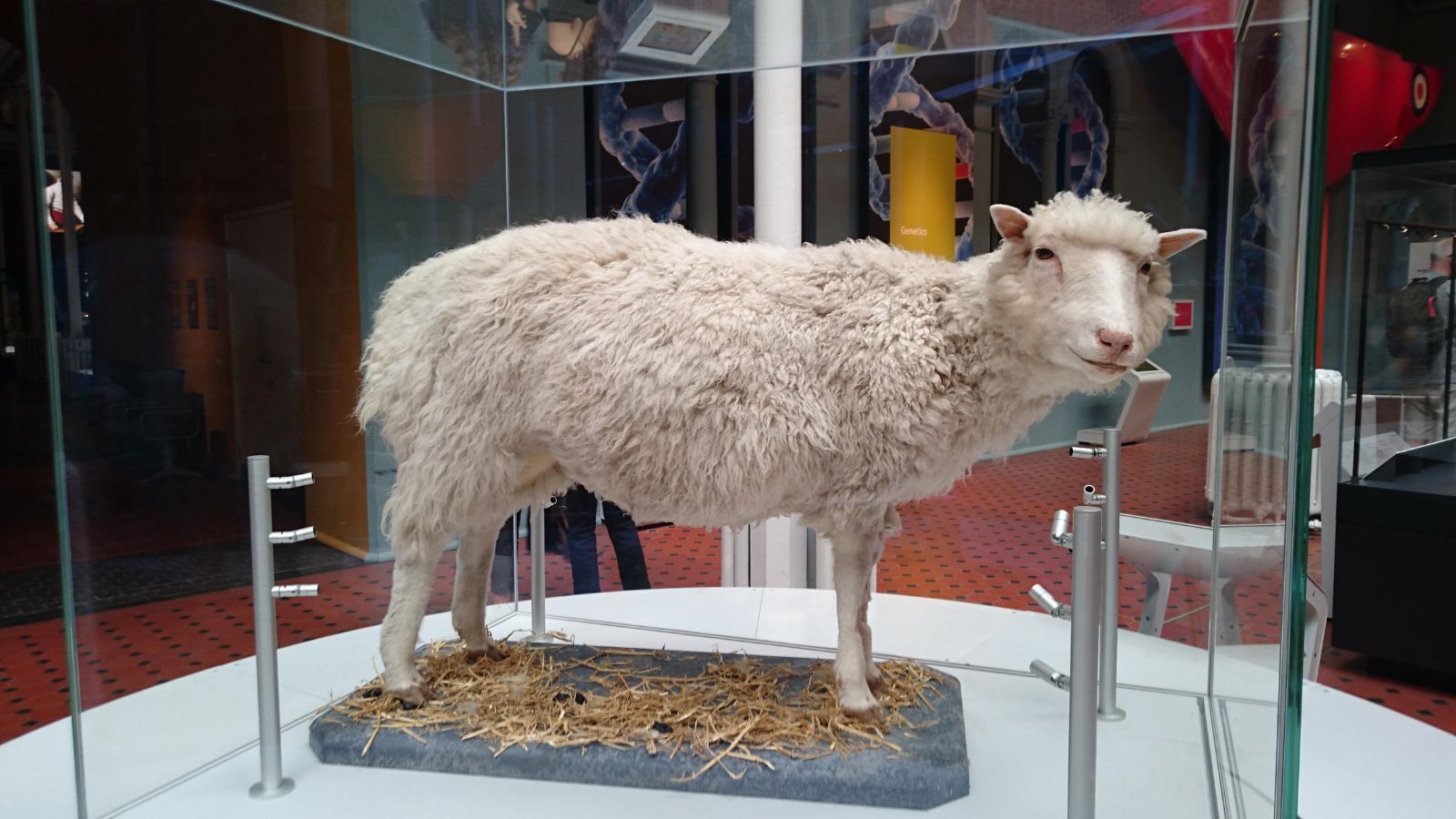
 Dolly the sheep may have been the world's most famous clone, but she was not the first. Cloning creates a genetically identical copy of an animal or plant. Many animals - including frogs, mice, sheep, and cows - had been cloned before Dolly. Plants are often cloned - when you take a cutting, you are producing a clone. Human identical twins are also clones.
Dolly the sheep may have been the world's most famous clone, but she was not the first. Cloning creates a genetically identical copy of an animal or plant. Many animals - including frogs, mice, sheep, and cows - had been cloned before Dolly. Plants are often cloned - when you take a cutting, you are producing a clone. Human identical twins are also clones.
So Dolly was not the first clone, and she looked like any other sheep, so why did she cause so much excitement and concern? Because she was the first mammal to be cloned from an adult cell, rather than an embryo. This was a major scientific achievement, but also raised ethical concerns.
Since 1996, when Dolly was born, other sheep have been cloned from adult cells, as have mice, rabbits, horses and donkeys, pigs, goats and cattle. In 2004 a mouse was cloned using a nucleus from an olfactory neuron, showing that the donor nucleus can come from a tissue of the body that does not normally divide.
How was Dolly created?
Producing an animal clone from an adult cell is obviously much more complex and difficult than growing a plant from a cutting. So when scientists working at the Roslin Institute in Scotland produced Dolly, the only lamb born from 277 attempts, it was a major news story around the world.
To produce Dolly, the scientists used the nucleus of an udder cell from a six-year-old Finn Dorset white sheep. The nucleus contains nearly all the cell's genes. They had to find a way to 'reprogram' the udder cells - to keep them alive but stop them growing – which they achieved by altering the growth medium (the ‘soup’ in which the cells were kept alive). Then they injected the cell into an unfertilised egg cell which had had its nucleus removed, and made the cells fuse by using electrical pulses. The unfertilised egg cell came from a Scottish Blackface ewe.
When the scientists had managed to fuse the nucleus from the adult white sheep cell with the egg cell from the black-faced sheep, they needed to make sure that the resulting cell would develop into an embryo. They cultured it for six or seven days to see if it divided and developed normally, before implanting it into a surrogate mother, another Scottish Blackface ewe. Dolly had a white face.
From 277 cell fusions, 29 early embryos developed and were implanted into 13 surrogate mothers. But only one pregnancy went to full term, and the 6.6kg Finn Dorset lamb 6LLS (alias Dolly) was born after 148 days.
Why are scientists interested in cloning?
The main reason that the scientists at Roslin wanted to be able to clone sheep and other large animals was connected with their research aimed at producing medicines in the milk of such animals. Researchers have managed to transfer human genes that produce useful proteins into sheep and cows, so that they can produce, for instance, the blood clotting agent factor IX to treat haemophilia or alpha-1-antitrypsin to treat cystic fibrosis and other lung conditions.
Cloned animals could also be developed that would produce human antibodies against infectious diseases and even cancers. ‘Foreign’ genes have been transplanted into zebra fish, which are widely used in laboratories, and embryos cloned from these fish express the foreign protein. If this technique can be applied to mammalian cells and the cells cultured to produce cloned animals, these could then breed conventionally to form flocks of genetically engineered animals all producing medicines in their milk.
There are other medical and scientific reasons for the interest in cloning. It is already being used alongside genetic techniques in the development of animal organs for transplant into humans (xenotransplantation). Combining such genetic techniques with cloning of pigs (achieved for the first time in March 2000) would lead to a reliable supply of suitable donor organs. The use of pig organs has been hampered by the presence of a sugar, alpha gal, on pig cells, but in 2002 scientists succeeded in knocking out the gene that makes it, and these ‘knockout’ pigs could be bred naturally. However, there are still worries about virus transmission.
The study of animal clones and cloned cells could lead to greater understanding of the development of the embryo and of ageing and age-related diseases. Cloned mice become obese, with related symptoms such as raised plasma insulin and leptin levels, though their offspring do not and are normal. Cloning could be used to create better animal models of diseases, which could in turn lead to further progress in understanding and treating those diseases. It could even enhance biodiversity by ensuring the continuation of rare breeds and endangered species.
What happened to Dolly?
Dolly, probably the most famous sheep in the world, lived a pampered existence at the Roslin Institute. She mated and produced normal offspring in the normal way, showing that such cloned animals can reproduce. Born on 5 July 1996, she was euthanased on 14 February 2003, aged six and a half. Sheep can live to age 11 or 12, but Dolly suffered from arthritis in a hind leg joint and from sheep pulmonary adenomatosis, a virus-induced lung tumour to which sheep raised indoors are prone. On 2 February 2003, Australia's first cloned sheep died unexpectedly at the age of two years and 10 months. The cause of death was unknown and the carcass was quickly cremated as it was decomposing.
Dolly’s chromosomes were are a little shorter than those of other sheep, but in most other ways she was the same as any other sheep of her chronological age. However, her early ageing may reflect that she was raised from the nucleus of a 6-year old sheep. Study of her cells also revealed that the very small amount of DNA outside the nucleus, in the mitochondria of the cells, is all inherited from the donor egg cell, not from the donor nucleus like the rest of her DNA. So she is not a completely identical copy. This finding could be important for sex-linked diseases such as haemophilia, and certain neuromuscular, brain and kidney conditions that are passed on through the mother's side of the family only.
Improving the technology
Scientists are working on ways to improve the technology. For example, when two genetically identical cloned mice embryos are combined, the aggregate embryo is more likely to survive to birth. Improvements in the culture medium may also help.
Ethical concerns and regulation
Most of the ethical concerns about cloning relate to the possibility that it might be used to clone humans. There would be enormous technical difficulties. As the technology stands at present, it would have to involve women willing to donate perhaps hundreds of eggs, surrogate pregnancies with high rates of miscarriage and stillbirth, and the possibility of premature ageing and high cancer rates for any children so produced. However, in 2004 South Korean scientists announced that they had cloned 30 human embryos, grown them in the laboratory until they were a hollow ball of cells, and produced a line of stem cells from them. Further ethical discussion was raised in 2008 when scientists succeeded in cloning mice from tissue that had been frozen for 16 years.
In the USA, President Clinton asked the National Bioethics Commission and Congress to examine the issues, and in the UK the House of Commons Science and Technology Committee, the Human Embryology and Fertilisation Authority and the Human Genetics Advisory Commission all consulted widely and advised that human cloning should be banned. The Council of Europe has banned human cloning: in fact most countries have banned the use of cloning to produce human babies (human reproductive cloning). However, there is one important medical aspect of cloning technology that could be applied to humans, which people may find less objectionable. This is therapeutic cloning (or cell nucleus replacement) for tissue engineering, in which tissues, rather than a baby, are created.
In therapeutic cloning, single cells would be taken from a person and 'reprogrammed' to create stem cells, which have the potential to develop into any type of cell in the body. When needed, the stem cells could be thawed and then induced to grow into particular types of cell such as heart, liver or brain cells that could be used in medical treatment. Reprogramming cells is likely to prove technically difficult.
Therapeutic cloning research is already being conducted in animals, and stem cells have been grown by this method and transplanted back into the original donor animal. In humans, this technique would revolutionise cell and tissue transplantation as a method of treating diseases. However, it is a very new science and has raised ethical concerns. In the UK a group headed by the Chief Medical Officer, Professor Liam Donaldson, has recommended that research on early human embryos should be allowed. The Human Fertilisation and Embryology Act was amended in 2001 to allow the use of embryos for stem cell research and consequently the HFEA has the responsibility for regulating all embryonic stem cell research in the UK. There is a potential supply of early embryos as patients undergoing in-vitro fertilisation usually produce a surplus of fertilised eggs.
As far as animal cloning is concerned, all cloning for research or medical purposes in the UK must be approved by the Home Office under the strict controls of the Animals (Scientific Procedures) Act 1986. This safeguards animal welfare while allowing important scientific and medical research to go ahead.
Further information
The Roslin Institute has lots of information about the research that led to Dolly, and the scientific studies of Dolly, as well as links to many other sites that provide useful information on the scientific and ethical aspects of this research.
The report of the Chief Medical Officer's Expert Advisory Group on Therapeutic Cloning: Stem cell research: medical progress with responsibility is available from the UK Department of Health, PO Box 777, London SE1 6XH.
Further information on therapeutic cloning and stem cell research is available from the Medical Research Council.
Interesting illustrated features on cloning have been published by Time, New Scientist. BBC News Online has a Q&A What is Cloning?
IMAGE © THE ROSLIN INSTITUTE



